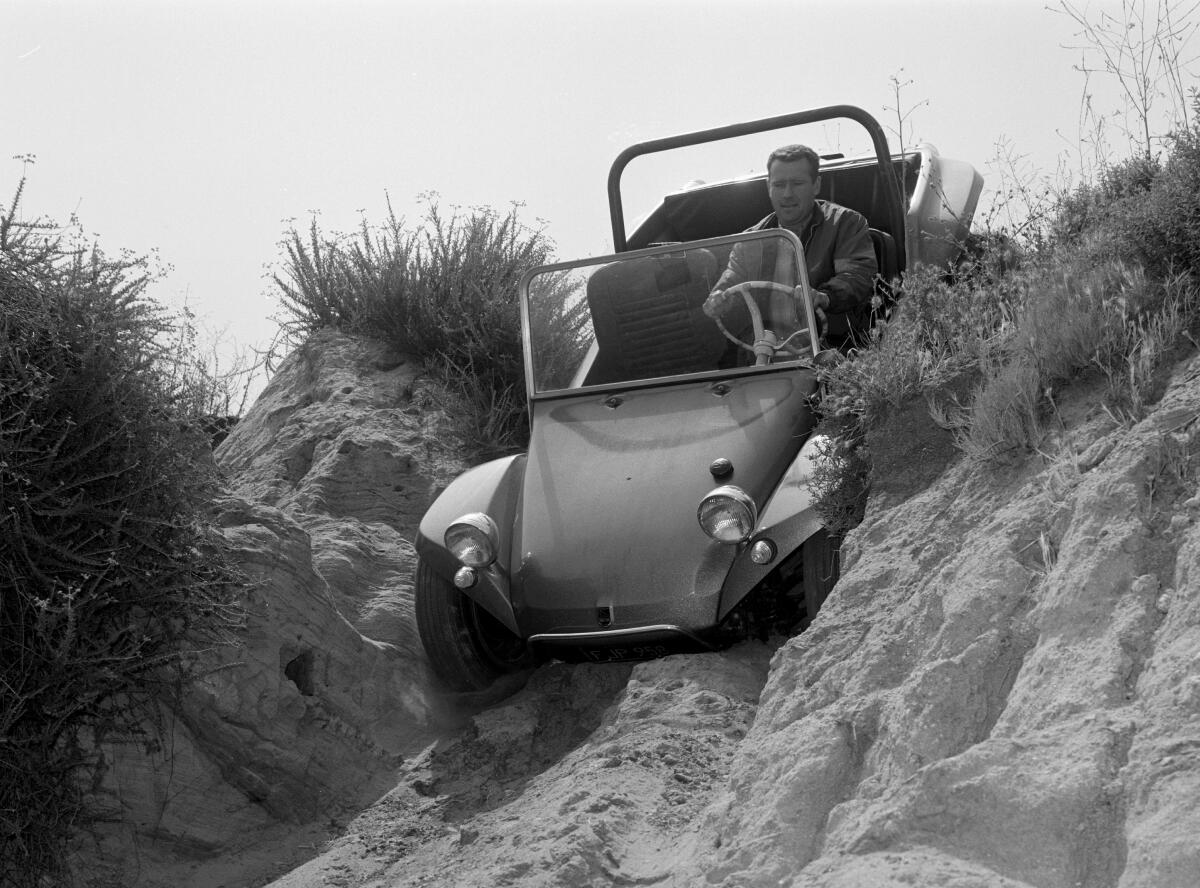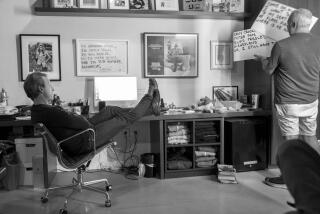Bruce Meyers, creator of fiberglass dune buggy who energized off-roading, dies

- Share via
Bruce Meyers was hanging out at Pismo Beach on California’s Central Coast one afternoon in 1963 when he saw something that both blew his mind and changed his life: a handful of old, stripped-down cars bouncing across the sand.
It sure would be fun to get behind the wheel of one of those, Meyers thought, if only they weren’t so ugly and didn’t appear so uncomfortable. He built his own solution: a “dune buggy” fashioned out of lightweight fiberglass mounted on four oversized tires with two bug-eyed-looking headlights and a blindingly bright paint job.
The result would become both an overnight automotive sensation and one of the talismans of California surf culture, especially when he created a space in the back to accommodate a surfboard. He called the vehicle the Meyers Manx and it turned the friendly, soft-spoken Meyers into a revered figure among off-roaders, surfers and car enthusiasts.
Meyers, who built thousands of dune buggies in his life, died Feb. 19 at his San Diego-area home, his wife, Winnie Meyers, said. He was 94.
Meyers also designed boats and surfboards, worked as a commercial artist and a lifeguard, traveled the world surfing and sailing, built a trading post in Tahiti and even survived a World War II Japanese kamikaze attack on his Navy aircraft carrier, the USS Bunker Hill.
“He had a life that nobody else has ever lived,” his wife said.
Bruce Franklin Meyers was born March 12, 1926, in Los Angeles, the son of a businessman and mechanic who set up automobile dealerships for his friend Henry Ford.
Growing up near such popular Southern California surfing spots as Newport, Hermosa and Manhattan beaches, it was wave riding, not cars, that initially captivated Meyers, who liked to refer to himself as an original beach bum.
He dropped out of high school and enlisted in the Navy and was aboard the Bunker Hill when it was attacked near Okinawa, Japan, on May 11, 1945. As fire raged aboard the ship, he jumped overboard, at one point handed his life preserver to someone who needed it more, and helped rescue others.
Later, his wife said, he returned to the ship and helped remove the bodies of the nearly 400 sailors killed.
After the war he served in the Merchant Marine and attended the Chouinard Art Institute, now part of the California Institute of the Arts.
He began by building boats, learning to shape lightweight but sturdy fiberglass. That experience gave him skills he would put to use in building the first dune buggies. He built his first 12 mainly for himself and friends, and decades later was still driving No. 1, which he named Old Red.
He and his friends had fallen in love with surfing the more rugged and less crowded beaches of Mexico’s Baja California and they figured a Meyers Manx would be perfect for driving over and around the area’s sand dunes.
“All I wanted to do was go surfing in Baja when I built the dang thing,” he told broadcaster Huell Howser when he took the host of Public Television’s “California Gold” program for a spin in Old Red in 2001.
Those first dozen cars were built without chassis, which hold in place the axels, suspension and other key parts of a vehicle’s undercarriage. Not having one made the car lighter but illegal to drive on public roads.
Meyers began adding chassis to his models and created kits that people could initially buy for $985 and build their own cars.
What really caused sales to take off, though, was when Meyers and friends took Old Red to Mexico in 1967 and won a 1,000-mile off-road race that took drivers through steep gullies, across soft sand and past other obstacles. Old Red won in record time, shattering the previous mark by more than five hours.
“Almost overnight we had 350 orders,” Meyers told the New York Times in 2007.
Soon afterward, the road race became officially known as the Mexican 1,000 — since renamed the Baja 1,000 — and when a Meyers-built dune buggy won that one too the orders poured in.
In all, B.F. Meyers & Co. built more than 6,000 Meyers Manx dune buggies. Although he trademarked the design, it was easy to borrow from it, and deep-pocketed competitors sold more than 250,000 copycats.
The Historic Vehicle Assn. says the Meyers Manx is the most replicated car in history.
Fed up with losing control of his invention, Meyers closed his company in 1971 and went on to other things. At one point, his wife said, he sailed to Tahiti with a wealthy sponsor and built and ran a trading post.
He and his wife re-established the car business in 1999, by which time there were dune buggy clubs all over the world. They sold the business to a venture capital firm last year.
Asked over the years what it was about the dune buggy that so captivated the public, Meyers said several things played into its success.
One was the cars’ bright colors and big tires, which gave them almost a cartoonish look. Another was the flat surface of the fenders, which were a perfect place to put a beer. There was also the spot in the back designed for a surfboard.
That, he and others noted, captivated people at a time when California surf culture was being glorified in movies and song.
The car, with Elvis Presley at the wheel, is featured in the opening credits to the 1968 film “Live a Little, Love a Little.” To this day, children still play with Meyers Manx Hot Wheels.
As Road and Track Magazine stated in 1976: “The Manx has to rank as one of the most significant and influential cars of all time. It started more fads, attracted more imitators … and was recognized as a genuine sculpture, a piece of art.”
In addition to his wife, Meyers is survived by a daughter, Julie Meyers. Two children, Georgia and Tim, preceded him in death.
More to Read
Start your day right
Sign up for Essential California for the L.A. Times biggest news, features and recommendations in your inbox six days a week.
You may occasionally receive promotional content from the Los Angeles Times.






